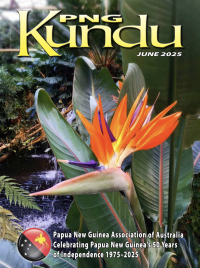Book reviews: March 2013
Mangroves, Coconuts and Frangipani: The Story of Rabaul by Neville Threlfall
Porton: A Deadly Trap by Audrey Davidson and Battle Survivors
Mangroves, Coconuts and Frangipani: The Story of Rabaul by Neville Threlfall
ISBN 978-0-646-58310-5 Published 2012. Soft Cover, 533 A4 pages of text. Foreword by Dr Allan Marat, MP for Rabaul. 150 photographs, 6 maps, Bibliography and Sources, Index. RRP in Australia $45, plus packing and postage on individual mail orders. In New Zealand, NZ$56, plus p&p. Order from Rev. Neville Threlfall, Unit 91, Nareen Gardens,19 Bias Avenue, Bateau Bay NSW 2261. Email: threlfallnm1@bigpond.com
This book is as close as we’ll ever get to have the definitive written account of the history of Rabaul. It really is an incredible book.
The author, Neville, is a pretty amazing sort of a man. He spent 19 years living in and around Rabaul and the islands through the 60s and 70s, working as a missionary with the Methodist Church, then with the Uniting Church of PNG. He immersed himself in the local communities, learnt their languages, customs and stories, and basically got to know the people as few others have. And he is still held in extremely high regard by the locals. Before he wrote this book, Neville had already written a commissioned history of the PNG Islands. Due to his background, he was a natural to write a Rabaul history. Neville collected a vast amount of information for this, through painstaking research, delving into government archives, colonial records and the like, interviewing experts in various fields, and talking with many, many people. The scope of it all is huge.
The book covers Rabaul and the Gazelle Peninsula area of ENB. Neville explains the main title of the book: “Mangroves” relates to the original waterfront of parts of the harbour which were covered in mangroves (Ra Baul in the local Tolai language, meaning mangroves), “Coconuts” relates to its product, copra, which brought the first trade to the area, and “Frangipani”, which has become the official emblem of the region, as after eruptions and wars they bloom again, giving hope to the people.
The story of Rabaul is told in chronological order, beginning with the geology of the area, and the inherent volcanic activity, the make-up of the landscape, why it has such a wonderful deep natural harbour. It details the first human movement through the Pacific, and early habitation in Rabaul’s surrounding areas. Other sections of the book cover early tribal movement and conflict (including the impact of New Ireland people who displaced the earlier coastal groups which were forced inland to make the Baining mountains their home), on to early Western influences, missionaries, trade and commerce in the region, the movement of Chinese workers to the town, who brought their own culture and often stayed on to be very successful. The period of German colonization had a huge impact on the development of the region, its infrastructure, and the expansion of trade. WW I disruption, Australian Administration, through the 1930s and the depression years, the 1937 eruptions, WW II and Japanese occupation (and the subsequent devastating effects on the people, and near destruction of the town of Rabaul), are all detailed in great accuracy and depth. Following chapters detail the rebuilding of Rabaul after the war, the lead up to PNG Independence, and the subsequent years, and an added section which deals with the 1994 eruptions, and on to Rabaul of today.
Frazer Harry
Porton: A Deadly Trap by Audrey Davidson and Battle Survivors
ISBN: 978 0 646 44766 7 Published by Boolarong Press. Paperback $25.00. publish@boolarongpress.com.au
In July 2003, Audrey Davidson gave a video presentation and address to an 11 Brigade Reunion luncheon in Brisbane. Her film featured the cathartic visit she had made some months earlier to a beach near Soraken in North Bougainville around which the WWII Battle of Porton Plantation had raged during the fateful hours of 8-10 June 1945.
Her father, Captain Clyde Downs, who commanded the 31/51 Australian Infantry Battalion attack force, was killed in action. His body was never found.
“PORTON”: a Name, a Beach, a Plantation,
A Battle a Betrayal, a Bitter Memory
Porton is a name which can still strike dread into the hearts of men. A handful of elderly veterans remember the beach at Porton Plantation on the island of Bougainville. In June 1945 they survived the brief but bloody offensive which took place there eight weeks before the end of WWII. Some of those diggers are still fighting that old battle. The men were driven to the limit of endurance on Porton beach. During three terrible days of fighting there they were forced to witness many of their mates being needlessly killed or wounded by Japanese gunfire in an operation which was known to be both pointless and unwarranted. The full facts were never revealed and the survivors have bitter memories.




